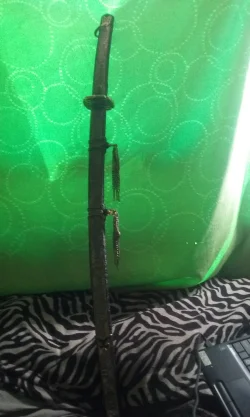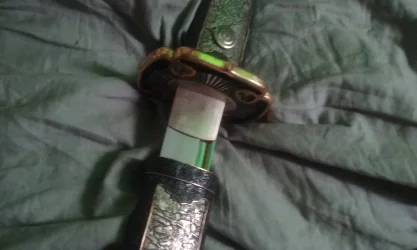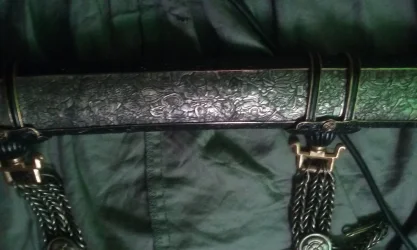Navigation
Install the app
How to install the app on iOS
Follow along with the video below to see how to install our site as a web app on your home screen.
Note: This feature may not be available in some browsers.
More options
Style variation
You are using an out of date browser. It may not display this or other websites correctly.
You should upgrade or use an alternative browser.
You should upgrade or use an alternative browser.
oaktree
Master of Arts
Have no idea unless the sword was taken apart to see if there is a name for the sword maker, the sword may be from the second war. I have held a kodachi from the Edo period feels very different then modern swords and the look also differs too.
Take it to an antique dealer and have them evaluate it.
Take it to an antique dealer and have them evaluate it.
Chris Parker
Grandmaster
Hi jadessway. It's an interesting piece… overtly, it's an example of Japanese naval mountings as used in WWII (and a bit before), but a rather ostentatious form of it (which is fairly unusual). I'd suggest it was most likely worn by someone of relatively high rank, and some funds… but the thing to understand about sword appraisal is that the fittings are the least of the entire equation… the blade itself is what matters. And, in your pictures, there is almost no sign of the blade at all. The small section that can be seen shows that there is a bo-hi (groove) present, but not much else… there's not much shown of the hamon, the grain isn't viewable, and more… which doesn't help.
In order to actually get a definitive answer, it'd help to get some good pictures of the blade itself, both very close up, and of the entire length (preferably taken out from the tsuka so the nakago can be inspected) on both sides. There'd need to be pictures of the kissaki (tip), any small chips or inconsistencies in the blade edge itself (ha), and detailed photos of the nakago (the tang, the part of the blade that extended inside the tsuka, the handle). The nakago is where we can tell the age (potentially, at least), as well as see any actual identifying marks, such as a mei (signature).
The most likely upshot, however, is that it's a gunto (military sword), likely an oil-cooled, mass-produced item of little actual value… but you never know. I don't know that I'd necessarily trust an antique dealer overtly to be able to appraise a nihonto, though… it's rather a specialised skill set, and most simply don't deal in enough to actually get the proper knowledge and experience in this field.
In order to actually get a definitive answer, it'd help to get some good pictures of the blade itself, both very close up, and of the entire length (preferably taken out from the tsuka so the nakago can be inspected) on both sides. There'd need to be pictures of the kissaki (tip), any small chips or inconsistencies in the blade edge itself (ha), and detailed photos of the nakago (the tang, the part of the blade that extended inside the tsuka, the handle). The nakago is where we can tell the age (potentially, at least), as well as see any actual identifying marks, such as a mei (signature).
The most likely upshot, however, is that it's a gunto (military sword), likely an oil-cooled, mass-produced item of little actual value… but you never know. I don't know that I'd necessarily trust an antique dealer overtly to be able to appraise a nihonto, though… it's rather a specialised skill set, and most simply don't deal in enough to actually get the proper knowledge and experience in this field.
pgsmith
Master of Arts
I agree with Chris that you need more pictures.
There is a really good description of how to take photos, and what photos to take, in order to figure out what sword you have on Swordforum's Nihonto forum ... Posting Sword Photos
You can also get the opinion of many knowledgeable Japanese sword collectors at Nihonto Message Board
Looking forward to more pictures!
There is a really good description of how to take photos, and what photos to take, in order to figure out what sword you have on Swordforum's Nihonto forum ... Posting Sword Photos
You can also get the opinion of many knowledgeable Japanese sword collectors at Nihonto Message Board
Looking forward to more pictures!
Yes, we need more pictures to help you out with this. Based on what we see I would guess like Chris that it is a gunto. However, without actually seeing the full blade we will not know for sure.
Similar threads
- Replies
- 1
- Views
- 1K
B
- Replies
- 0
- Views
- 2K
B
M
- Replies
- 4
- Views
- 2K
M



